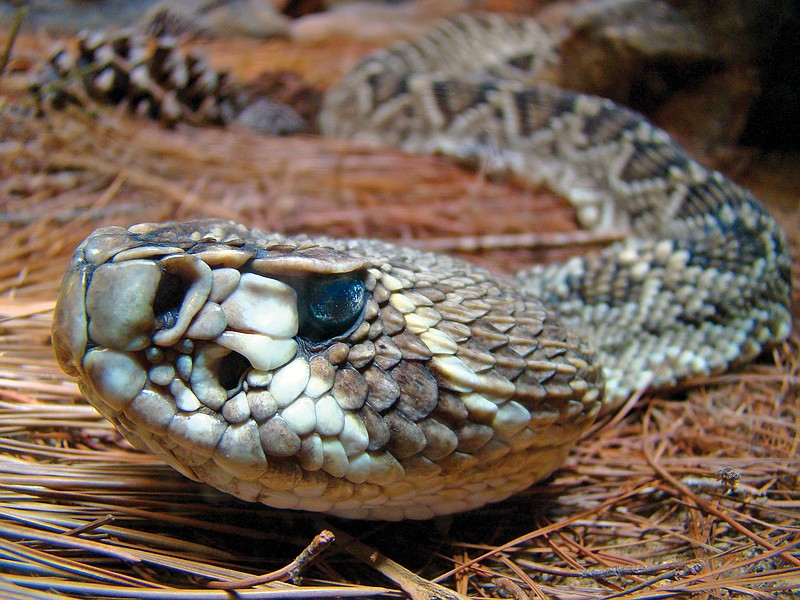Venomous or Not?
Aside from coral snakes, nonvenomous snakes traditionally have:* Tapered head* Double row of subcaudal scales on the distal anal plate* Round pupils and fixed teethTraditionally, venomous snakes have:* Triangular head* Single row of subcaudal scales* Heat-sensitive pit, elliptical cat-like eyes, retractable fangs, which are their only teeth.Who Cares? Stay Away!Moore strongly advises just staying away from the snake. “All of these things are true, but they are really subtle and things can change,” he says, adding that the hog snake, a nonvenomous snake, has evolved to learn how to triangulate and flatten its head to appear venomous.Note: Coral snakes are very different. They have a round head, fixed teeth and can generally be determined by their striping. Remember this rhyme: “Red next to yellow will kill a fellow. Red next to black is a friend to Jack.”
Did You Know?
Many people might see a snake swimming in a body of water and automatically assume it’s a water moccasin, but this isn’t necessarily true. “All snakes swim,” says Moore.
About Our Expert
Dr. Chris Moore is a medical doctor who has held many wilderness safety roles in the community during his tenure. He was the director of wilderness and event medicine at the UTC College of Medicine, helped start Baylor’s Walkabout program and Outdoor Chattanooga, and has served as trip physician on multiple outdoor excursions far and wide.
When Dr. Chris Moore gives educational presentations on snakebites, he likes to make his audience squirm with a nice, big picture of a snake to kick off his lecture.After watching their collective shudder, he'll ask, "Why is it we are so afraid of something that is a fraction of our size?"
It's a good question. Moore says whenever he gets the chance, he tries to educate outdoor lovers on the truth about these slithering reptiles. Should you happen to run into one on your next trek in the woods, here's what you should know.
First, some education
Out of the 120 species of snakes in the United States, only 19 of them are venomous, says Moore. Of those 19, two are coral snakes, one is the copperhead, another the water moccasin/cottonmouth, and the remaining 15 are various types of rattlesnakes.
A quick look at a snake distribution map will show you that, though cottonmouths' natural habitat isn't very far outside of Chattanooga, really the only snakes we have to be aware of in our area are the rattlers.
That being said, according to Moore there's a lot of misinformation floating around about these creatures. He says it's important to know that:
* Snakes are coldblooded animals with terrible vision and hearing. They're slow, lacking stamina, which means they won't go chasing after you if you leave them alone.
* They do, however, have a superior sense of smell and are extremely sensitive to heat and vibrations, which means they can easily sense when a large creature - like a human - is coming at them.
* "When we think snakes are out to get us, it's the furthest thing from the truth," says Moore. "All of this is set up for their adaptation to stay alive and to replenish as a species and to feed themselves. They're going, 'Oh my God, there's not a chance in the world I can take [that human] down and eat her.'"
* While it might be handy to know how to identify a venomous versus non-venomous snake, Moore says what's more important is to get out of the situation. "If you see a snake, there's really no reason to determine whether it's venomous or nonvenomous; just leave it alone," he says.
* Snakes don't want to waste venom. "We know now in between 30 and 50 percent of all bites from venomous snakes, no venom is released," says Moore. These are called "dry bites." The idea is that snakes use their venom to kill their prey so they can eat. Sensing the size of an average human, snakes generally can tell they can't eat such a large creature. Instead, they try to scare us away with a bite.
Taking Action
According to Moore, about 45,000 snakebites are reported every year in the U.S., and 9,000 of those people are treated for venomous snakebites. Death by snakebite does not exceed 10 to 12 people per year, he says.
Bites largely occur on the upper extremities, and men are seven to nine times more likely to be bitten than women, largely because they'll be the ones to go up to the snake and try to grab it, Moore laughs. Though it's rare, a snakebite can happen. If it does, here's what you should (and should not) do:
* DO NOT panic. Remember, there's a 30-50 percent chance the bite wasn't venomous. Examine the wound and look for signs of swelling and severe pain. Note: A venomous bite can have anywhere from one to four puncture marks, as a rattlesnake can already be growing a second pair of teeth in the back of its mouth in case its current fangs get broken off.
* DO NOT try to cut the wound and suck out the venom. Cutting could introduce more bacteria into the wound and damage the arteries and nerves. Also, it's highly unlikely you'll be able to access the venom pool secreted by the snake's curved fangs. Basically, there's too much risk involved for a method that has not been proven effective, says Moore.
* DO NOT use a tourniquet. "Venom is spread through tissues and the lymph system, not arteries," Moore explains. "When you put a tourniquet and occlude veins and arteries, you're not helping the snakebite. What you are helping is the possibility to kill the arm or leg."
* If you didn't get a good look at the snake to determine if it's venomous or not, DO NOT go looking for it. While the snake probably hasn't gone very far if the bite was recent, sending someone off to find or kill it is really unnecessary. First, it could create another victim and delay getting help for the current victim. Second, emergency room doctors most often specialize in caring for snakebites, not identifying venomous snakes, says Moore. Then there's the fact that a snake's head can still bite for up to 60 minutes after being severed from its body.
* DO get to definitive care as soon as possible. The only known cure for a snakebite is a dose of antivenin. Let's say you're hours out onto the trail when you get bitten, and the wound is swelling and the pain severe. How long do you have? Moore says it depends on your body size and where you were bitten. For instance, if you were bitten on an artery, the venom will travel faster throughout your body. But ultimately, "You have to get to definitive treatment as quickly and in the best way you can," says Moore.

